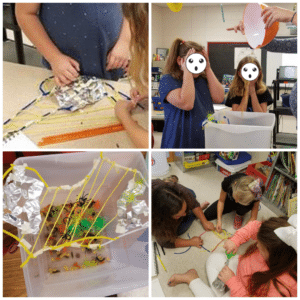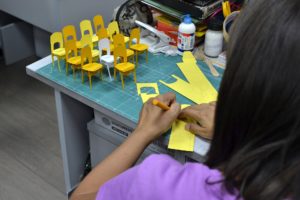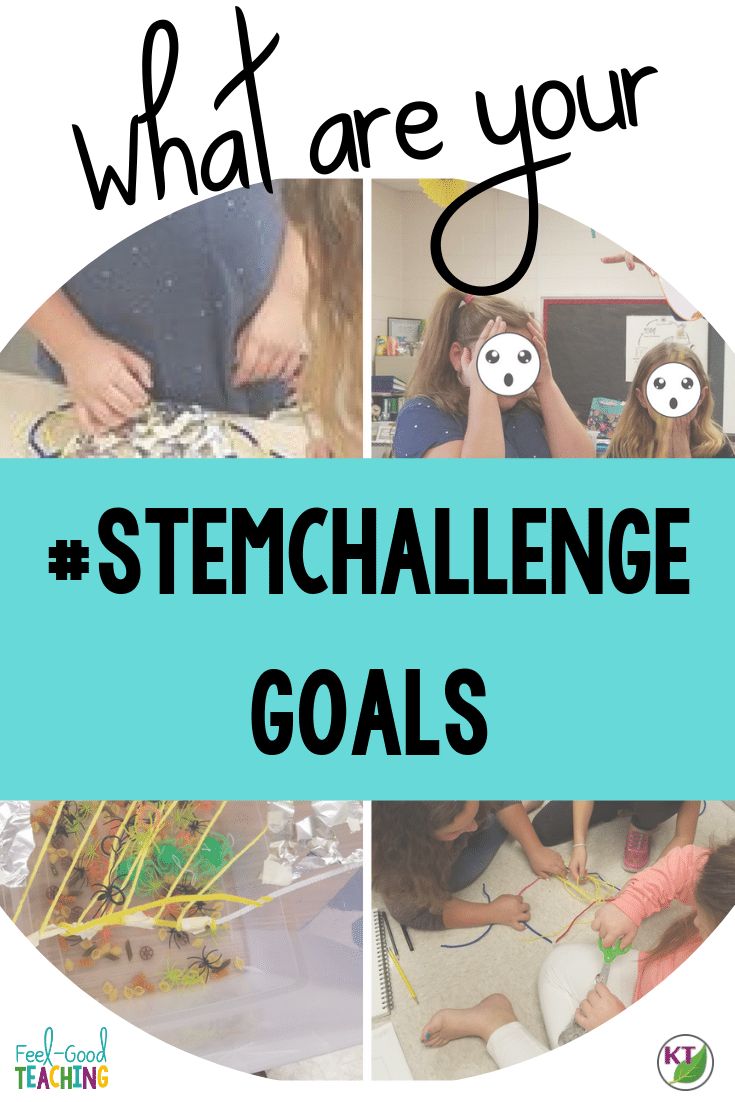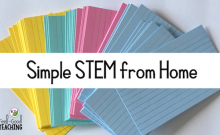Doing STEM Challenges with your students can serve so many goals, that’s why I’ve been proclaiming my love for them from the mountaintops for almost a decade now! But one thing I’ve noticed that makes a huge difference in the quality & approach to facilitating STEM Challenges is taking the time to set your intention — to really lay out your “whys” for devoting class time to these special activities. When we do that, we get and give our students much deeper learning experiences!

Why Do STEM Challenges?
As I mentioned, there are plenty of reasons to do STEM Challenges with your students! Today, I’m sharing my most important “whys” and next week, I’ll share how my “whys” guide what I do and don’t do as a STEM Challenge facilitator — and why it’s so important to stay tapped into your “whys”!
Hands-on, Constructivist Learning
I believe in an academically rigorous, well-rounded, child-centered curriculum that fosters growth with high expectations and positive reinforcement. In my experience, learning is most powerful when students are empowered to explore concepts and piece things together themselves. Working with your hands activates so many areas of the brain that paper/pencil tasks can’t do. STEM Challenges just jive perfectly with my teaching philosophy. As long as they are thoughtfully planned (more on this next week), they are exceptionally rigorous, while also being fun for students. Fun with substance is always my preferred approach to teaching and learning!
 Develops Growth Mindset
Develops Growth Mindset
Buzzword alert! We know growth mindset is quite en vogue at the moment, and there’s good reason for that. Students who have growth mindsets tend to be better equipped to face tough problems in school and in life than those with fixed mindsets. Traits associated with growth mindset include resilience, persistence, self-reliance, and comfort with productive failure. When students have practice in environments where failure is not only safe, but expected and welcomed with curiosity and determination, they become more confident and fearless. One of the many beautiful benefits of STEM Challenges is that they are built to be tough, so students will encounter many opportunities to practice and develop growth mindsets.
Levels the Playing Field
Teachers are all familiar with multiple intelligences and the importance of honoring those talents in our classrooms, but it can sometimes be hard to do. I have found STEM Challenges give different students a chance to shine than the usual suspects, and the experience is formative for so many students.
I will never forget an experience with one of my high-achievers (Hannah) and one who struggled with the traditional paper/pencil academic tasks (Raul). As is not unusual, high-achieving Hannah was a bit frustrated by a challenge. Hannah’s type don’t always fare well with the open-ended nature of STEM Challenges. There is no direct road map for success, just the guide rails of the Criteria & Constraints List, which can feel frustratingly like flying blind for some. Raul, however, relished the opportunity to explore with such freedom. Raul’s ideas were fascinating and exalted by his group members.
I saw Raul’s pride in his ideas and design, and I also saw his peers gain a new respect for him and his intellect. Those high achievers don’t always get enough experiences with academic hardship and failure, and that’s not good for them. All students should get those experiences early and often so they learn how to cope and push through the discomfort. And that newfound feeling of discomfort and not knowing what to do — that helps the Hannahs of the word understand and empathize better when others struggle in areas in which they shine. They start to grasp that there are many ways to be “smart” and that smart is more fluid than rigid.
Students like Raul are all-too-often starved for the opportunity to shine and show off their gifts. Something magical happens in classrooms when they are given the chance — success begets more success! The confidence students gain with each chance to shine spills over into the rest of their academic tasks as well. Win-win-win!
Physical Context for Standards-Based Lessons
Teachers are often asked to activate background knowledge in students to scaffold new learning experiences. That can be easier said than done given the extremely diverse backgrounds in many of our classrooms, right?! Starting off a unit with a STEM Challenge ensures all students have some background from which to draw. Further, if you leave the designs on display, there will be a physical object in the room the students care about that you can connect with standards-based lessons. Sweet! And the fabulous thing is that it doesn’t have to stop with NGSS, or even STEM subjects! I connect everything I can, which means all of my STEM Challenges also tie in other subjects like ELA, social studies, and even art, music, and PE. I’m all about getting all the juice for the squeeze!
Engagement & Culminating Activities
This one has some overlap with the “why” above, of course, but there are a few extra points to make! Whenever possible, I like to do STEM Challenges in two (or sometimes more) iterations. Multiple iterations are part of the
NGSS and engineering design process, but there’s another reason for them other than that you’re supposed to do them! I find that starting off a unit with a STEM Challenge creates a higher level engagement in the standards-based lessons/activities/inquiry that follow, which means less re-teaching and more time for deeper-level learning. When I cap the unit with a second iteration, students are able to apply what they’ve learned to improve their designs.
But if for some reason I have to choose to do a challenge just once, I always choose it as an engagement activity. Why? First, as I already mentioned, it gets me better buy-in for the lessons I am about to teach. Second, I get a better variety in designs and more creativity before I’ve taught or they’ve done research. That’s because once students are exposed to possible solutions to problems, they tend to replicate rather than innovate, and that’s just not nearly as interesting or rich in terms of brain-busting work!
Critical Thinking & Problem Solving
Good STEM Challenges are meant to be hard; “challenge” is right in the name, after all! Hard is good! Don’t shy away from it, unless you want your students to too — and I know you don’t want that! You want to be able to present students with a novel problem and have them attack it from several angles, right? And that’s just what happens with a STEM Challenge. You give each group a set of parameters (AKA: Criteria & Constraints List) and materials, and watch how many paths they find to a solution. I am always blown away at the variety in the designs, and so are the students. There is something powerful in tangible evidence that problems have myriad solutions! Sometimes, of course, they won’t find success in the first iteration of a STEM Challenge. As I mentioned in the growth mindset section this is an opportunity! This is your chance to help students analyze, reflect, and try again!
Collaboration / Teamwork / Advocacy
Listen, I am not even going to try to pretend that team isn’t sometimes a four-letter word. There have been times in my life as teacher and student I felt that deep in my soul! Truly! In terms of teamwork, STEM Challenges can bring the best of times and the worst of times! Oh, yes, there will be tears! There will be huffs and puffs and heated disagreements. There will be hurt feelings.You know what else there will be: Triumphs and epiphanies that sometimes the whole can be greater than the sum of its parts. Another handy thing to help students work on when it comes to collaborating is finding fair ways to compromise and select opportunities. If you have time for class meetings, these topics can generate incredible discussions and insights. Another topic to brainstorm on and discuss is ways to appropriately advocate for your ideas in a group setting. So much fertile ground to work on skills that, let’s face it, most of the population will need to be successful in their future careers!
Creativity / Risk-Taking
Yep, STEM Challenges usually result in students solving the same problem in wildly different ways! Students love to impress their peers and have their designs stand out.You can sort of turbo charge that creativity when you hold multiple iterations because students can really allow themselves to think freely in the first go of it because they know a second chance will come. If I’m doing a good job as a facilitator, students become less focused on what I might expect or consider a successful design and become more focused on making something new, unusual, or unexpected — even if that means they might fail in the attempt. The more STEM Challenges you conduct, the more creative and comfortable students get with taking risks. Every bold, successful entrepreneur is comfortable taking risks and trying to accomplish what others might not think possible; I want my students to have that boldness of spirit, too!
The Bigger Picture
In fact, I often think about the bigger picture when it comes to teaching. What, ultimately, do I want for my students when they are grown up, and what do I want from society? Looking at my list of “whys” above, some of my hopes are already pretty clear. I want students to feel empowered and self-reliant. I want them to be confident in their ability to work through any problem life or work throws their way. I want them to be resilient and comfortable with productive failure as a necessary and unavoidable part of a full life. I want creative problem-solvers who think for themselves and don’t give up when things get tough. I want people who can work together and compromise, but who also have practice standing up for their ideas. I want people who can believe the big problems are solvable and are creative and ambitious enough to try.
That might sound like a lofty list of goals for STEM Challenges to deliver, but the last decade has convinced me that there is no better, more complete way to practice the skills necessary for a full, rich, and beautiful life than STEM Challenges!
Be sure to check out how my whys guide my dos & don’ts for before, during, and after a STEM Challenge.
Let me know by commenting or reaching out directly!
Don’t Forget Me, PIN ME!

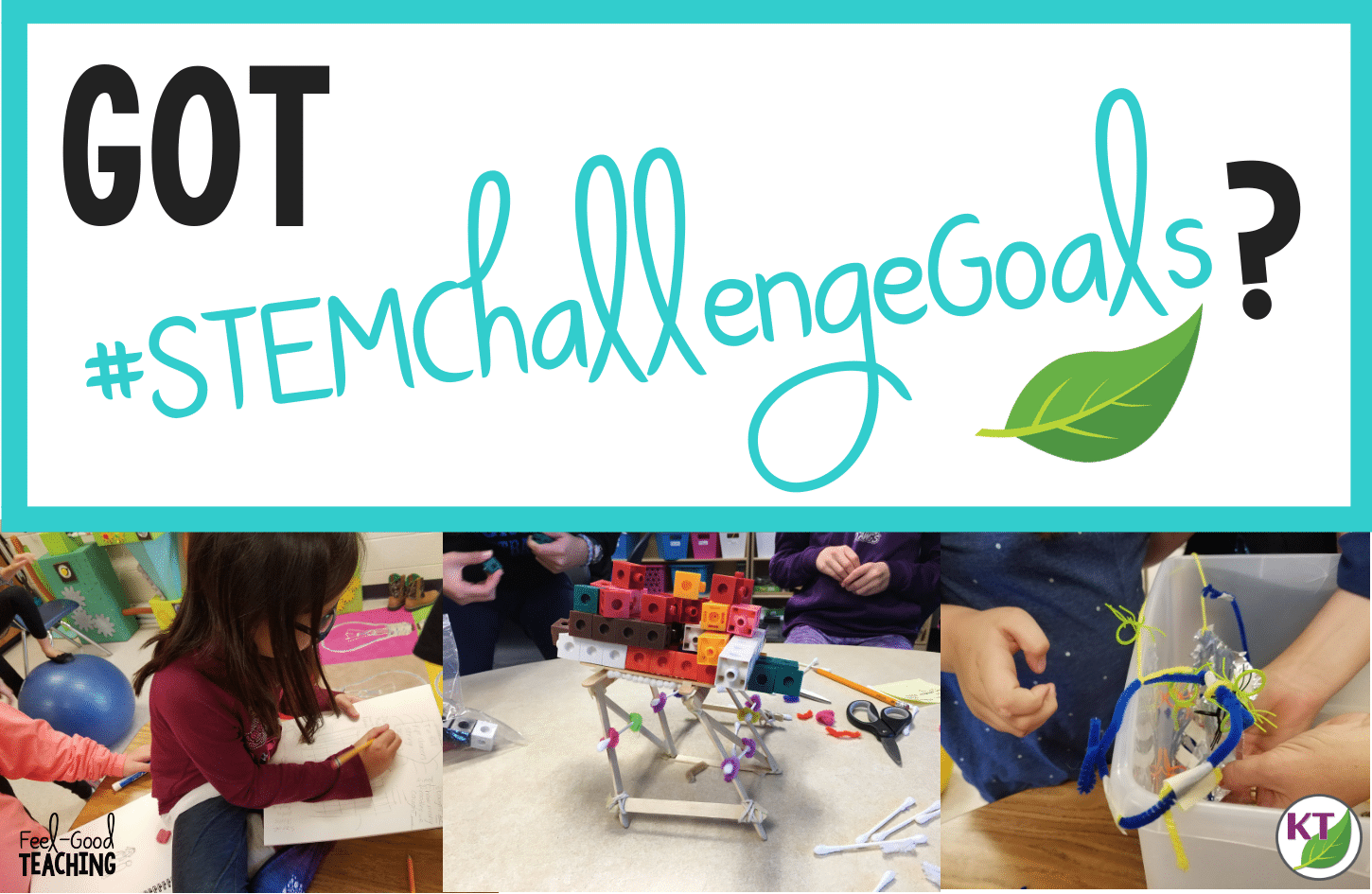

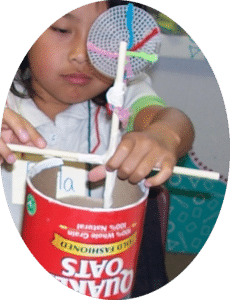
 Develops Growth Mindset
Develops Growth Mindset